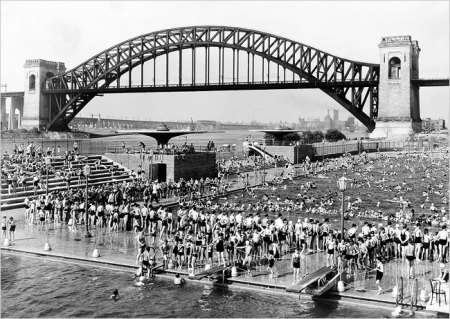Befitting uber New York builder Robert Moses and his unparalleled impact on the built environment, no less than three retrospective shows about his career are opening next month, reports the Times. You can read the piece for yourself, but here’s the money quote from deputy mayor Daniel Doctoroff:
“Can there be another time when you can get big projects done all over the city?” Mr. Doctoroff said. “I think the answer is yes, and we’re in one now. Could you ever have one person who with imperiousness, with concentrated power, with lack of community input, could get things done? The answer is no.”
A lesson Mr. Doctoroff learned firsthand, no doubt (ahem…westside stadium…cough cough).
When Jane Jacobs passed away last year, I noted here on Polis that it has become the contrarian fashion to say that Robert Moses wasn’t so bad after all. Now it seems we’ll have three exhibits to assess that viewpoint.
Click here for a slideshow (including the above pic of Astoria pool).






I read the article in the “Times” and also attended a “warm-up” event a few weeks ago at the CUNY Graduate Center (“Jacobs vs. Moses”), and it seems to me that there are quite a number of conceptual and logical errors with the pro-Moses (and, by implication, the anti-Jacobs) arguments that are being presented in these various forums. Here are just some of them:
1) Robert Moses, and the Moses “approach,” respresents the be-all and end-all in the construction of necessary large infrastructure projects in NYC; therefore we must once again emulate his aims and, with certain modifications, his methods, like the abuse of eminent domain — as though nothing “big” and necessary was ever built before or after Robert Moses.
What about the construction of the New York City water system, the New York City subway system, most of New York City’s great bridges, the boulevards in the outer boroughs, etc., etc.? And speaking of private developments, what about such large (enormous) scaled developments as the introduction of the Pennsylvania Railroad to Manhattan (resulting in the original Pennsylvania Station and west side rail yards — not to mention that viaduct in Queens and Hell’s Gate bridge), the rebuilding of the New York Central rail yards in East Midtown (resulting in Park Ave. and the Grand Central Terminal complex), Rockefeller Center, Tudor City, etc. etc.?
2) To be anti-Moses (and pro-Jacobs) means that one is unalterably opposed to “big” projects.
Jacobs wasn’t against “big” projects per se; she was against BAD “big” projects — and the inept handling of the problems that even good “big” projects create (see quote at the end of this post):
3) Moses’ big projects laid the ground work for New York City’s current rebound.
The areas of New York City that have experienced the earliest and most intense revitalization (e.g., the West Village, SoHo, Tribeca, Flatiron District, Chelsea, East Village, etc.) are usually those that were least affected by Moses — with the areas closest to nearby Moses projects experiencing the latest and least intense revitalizations.
4) The current wave of popular “big” projects are Robert Moses-type projects.
I can’t believe that Doctoroff is trying to pass off projects like the Second Ave. subway, the Grand Central connector, the extension of the #7 train as big “Robert Moses-type” projects. These are just the kinds of projects that his opponents wanted and that Moses tried to stop or discourage!!
5) The critics of Moses claim that he never, ever built anything that was good.
This is clearly untrue. Even Caro in the “Power Broker” seems to admire a good number of his projects. I would say the conventional wisdom, valid or not, all along has been that his early works were pretty good, but that he then got sidetracked by power and megalomania.
– – – – – –
From a longer version of a published letter I wrote to “New York Times” Sunday Magazine:
And in her first and most famous book, “Death and Life of Great American Cities,” Jacobs mentions favorably, among other things, the Empire State Building, the Grand Central Terminal complex and Rockefeller Center. Furthermore, in that book she also states that,
“A big city needs universities, large medical centers, large parks containing metropolitan attractions . . . it needs some expressways (especially for trucking). The point is hardly to disdain such facilities as these or minimize their value. Rather, the point is to recognize that they are mixed blessings [and to find ways to counter their negative effects].”
What Jacobs was against, instead, were those “utopian” master plans, often primarily architectural in nature, that exhibited a willful ignorance of urban processes and were largely made possible by abuse of power (e.g., the abuse of eminent domain) and governmental financial legerdemain, etc.
– – – –
P.S. I met you at the Jane Jacobs event that you organized last spring — and didn’t realize at the time that I had enjoyed a number of your articles in the “Times”!